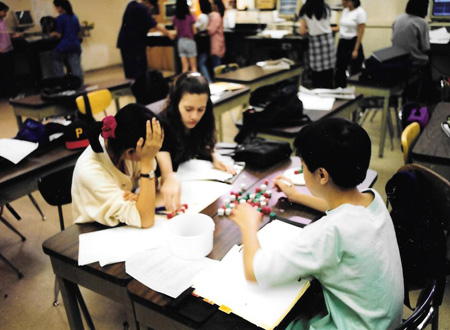Lab 8: -- Radioactive Decay

Problem: What is the relationship between the amount of radioactive decay and the time allowed for decay?
Materials: 100 die, graph paper,
Procedure: the 100 die represent 100 radioactive iodine-124 atoms. Place the 100 die into a paper bag and shake them up. Shake them out of the bag. Each die showing a number 1 face up represents an atom that has decayed. Remove all the atoms that decayed for the first toss (day one). Put the rest of the die back in the paper bag and shake them up again. Repeat the process for the second toss (representing day 2).
Results:
Complete the following table:
Time (days) Atoms remaining
0 100
1 ___
2 ___
3 ___
Continue till all atoms have decayed. This may take approximately 25 steps.
A) How long did it take for half the atoms to decay from 100 to approximately 50?
B) How long did it take for the atoms to decay half again (from about 50 to about 25?
C) How long did it take for the atoms to decay half again?
D) What is the average of the values in A , B and C?
If the equation of your data is approximately:
y = 100(0.83x)
Discussion:
1) What are the independent and dependent variables?
2) How are the variables changing with relationship to each other?
3) What happens to the dependent variable when the independent variable increases? decreases?
4) How does the relationship shown in this experiment compare with other relationships you have so far seen?
5) How does the equation for this relationship compare with those of other equations you have studied?
6) What is the meaning of half-life in a radioactive substance?
7) What is the approximate half-life of your experiment?
Lab Activities and Resources
What are Mathematical Relationships
What is a mathematical relationship and what are the different types of mathematical relationships that apply to the laboratory exercises in the following activities.
Labs
Lab 1: The Spring Constant -- Problem: What is the relationship between how much a spring stretches and the force pulling on the spring?
Lab 2: The Pendulum --Problem: What is the relationship between the period of a pendulum and the length of the string of the pendulum?
Lab 3: Mass, Volume and Density-- Problem: What is the relationship between the mass of a ball and its volume assuming a constant density?
Lab 4: Light Intensity-- Problem: What is the relationship between the intensity of a beam of light and the distance from a light source?
Lab 5: Acceleration-- Problem: What is a the relationship between how the distance travels and the time in travel for an accelerating object?
Lab 6: Polarization -- Problem: What is the relationship between how much light passes through a Polaroid filter and the angle the filter is rotated?
Lab 7: Ohms Law-- Problem: What is the relationship between current, voltage when there is a constant resistance in an electric circuit.
Lab 8: Radioactive Decay-- Problem: What is the relationship between the decay of radioactive material and the time allowed for the decay?
Lab 9: Water Pressure-- Problem: What is the relationship between water pressure and depth of water?
Lab 10: Attractive and Repulsive Forces-- Problem: What is the relationship between the distance between two magnets and the force between them?
Lab 11: Damping Motion-- Problem: What is the relationship between the height a ball bounces and the number of times it has bounced?